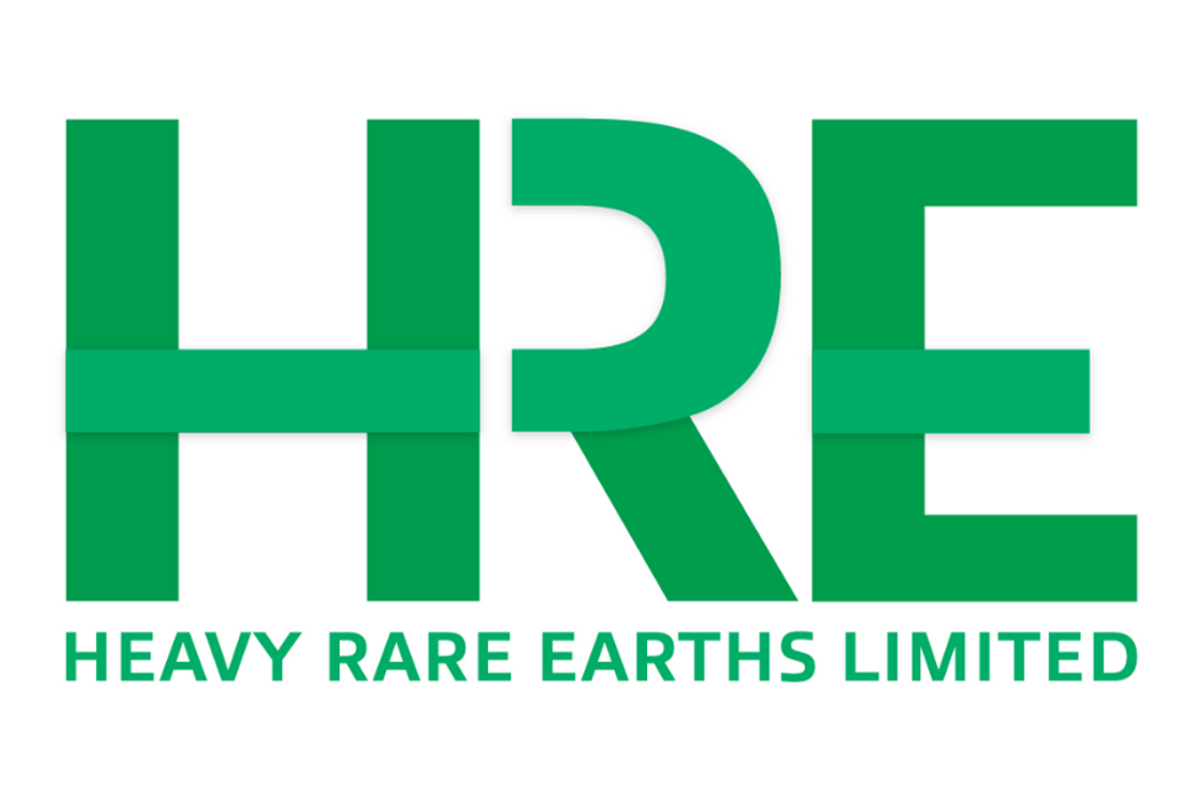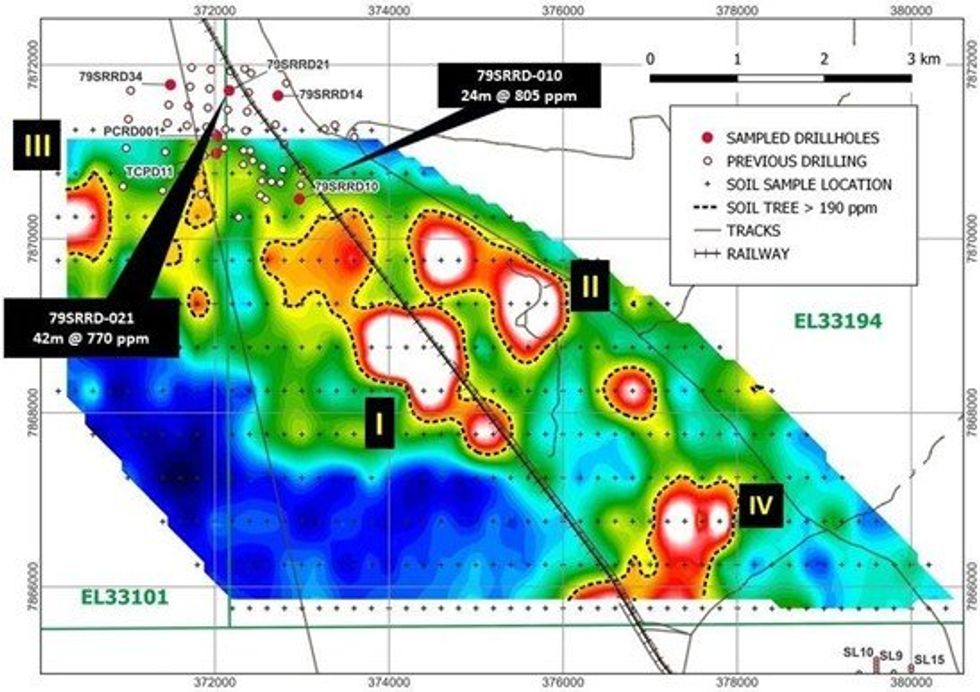
November 12, 2023
Heavy Rare Earths Limited (“HRE” or “the Company”) is pleased to report the results of soil and historic drill chip sampling at its 100 per cent-owned Duke project in the Northern Territory.
- Soil survey identifies 7 km2 zone of rare earth enrichment
- Major rare earth zone adjacent to historic drill intercepts in saprolite:
- 42 metres @ 770 ppm TREO from 8 metres
- including 6 metres @ 1481 ppm TREO from 12 metres
- 24 metres @ 805 ppm TREO from 4 metres
- including 6 metres @ 1281 ppm TREO from 12 metres
- 42 metres @ 770 ppm TREO from 8 metres
- Historic drilling has not tested the best rare earth soil anomalies
- Soil survey extends historic copper-bismuth-gold soil anomaly

HRE Executive Director, Richard Brescianini, said, “Assay results presented today indicate significant potential for a large saprolite-hosted rare earth deposit at Duke similar to our Cowalinya deposit in Western Australia. Additionally, the high rare earth grades within fresh Warrego Granite may also represent a secondary target, analogous to newly-discovered mineralisation in the Sybella Batholith near Mount Isa in Queensland by Red Metal.”
Soil Survey
HRE undertook an extensive 400 m x 200 m soil survey at Duke during August 2023 covering prominent thorium (Th) and uranium (U) airborne radiometric anomalies from past explorers, and including the area of quartz veining and elevated rare earths (REE) in surface samples reported previously (refer to ASX announcement 3 August 2023). A total of 470 soil samples including duplicates and certified reference material (CRM) were submitted to LabWest Minerals Analysis (LabWest) in Perth for assay via the Ultrafine+™ method.
Total rare earth (TREE) assay data is presented as an image in Figure 1. They reveal two parallel rare earth anomalies (I & II) the largest of which, Anomaly I, extends for 3.5 km in a NW-SE direction. Anomaly I is contiguous with a zone of elevated REE in saprolite identified from a program of drilling in the 1970s (next section).
Smaller anomalies (III & IV) occur in the west and south of the survey area. Both anomalies remain open. Anomaly IV is closely associated with numerous quartz vein outcrops and a zone of hydrothermal alteration inferred from airborne magnetic data.
The new soil data also confirm and extend a copper-bismuth-gold (Cu-Bi-Au) soil anomaly identified by a previous explorer (Figure 2). This anomaly extends over at least 5 km of strike and remains open to the south. The highest values recorded were 196 ppm Cu, 56 ppm Bi and 3.9 ppb Au. Several historic holes were drilled 500-850 m south of HRE’s EL33194 which returned modest Cu intersections including 3 m at 0.13% Cu (SLP001) and 6 m at 0.22% Cu (SLP002) with anomalous Bi and Au.
Sampling of Historic Percussion Chips and Drill Core
Numerous open hole percussion holes were drilled in the 1970s in the northern part and north of HRE’s soil survey area. Their locations are shown in Figure 1. The target was uranium, and the holes are coincident with an airborne radiometric uranium anomaly. In September 2023, drill chips from four of these holes were sampled by HRE at the Northern Territory Geological Survey core storage facility in Darwin, as was drill core from historic diamond hole TCPD11. Initial on-site chemical analysis was conducted using a portable XRF (pXRF) device. Two of the four percussion holes returned thick intersections of anomalous rare earths in saprolitic Warrego Granite (actually syenite) and this material was submitted for conventional assay at LabWest.
Assay results are presented in Table 1 and Figure 1. The best intersection was 42 m @ 770 ppm TREO from 8 m depth in hole 79SRRD-021. It is possible that some “smearing” of the samples occurred during drilling exaggerating the thickness of mineralisation. Nevertheless, these results point to substantial thicknesses of REE mineralisation in saprolite which, whilst contiguous with, do not coincide with the best rare earth soil anomalies.
Core hole TCPD11, which intersected fresh syenite of the Warrego Granite, was sampled using a pXRF at 1 m intervals from 49 m (start of core) to 153 m. This analysis returned elevated rare earths over the entire sampled interval. Assays of nine samples from across this interval at an average sample spacing of 10 m delivered rare earth grades in the range 536-1167 ppm TREO, averaging 839 ppm (Table 1). This is consistent with previously reported high rare earths in fresh Warrego Granite from hole PCRD001 using pXRF (refer to ASX announcement 3 August 2023) and subsequently verified using conventional chemical assay.
Click here for the full ASX Release
This article includes content from Heavy Rare Earths, licensed for the purpose of publishing on Investing News Australia. This article does not constitute financial product advice. It is your responsibility to perform proper due diligence before acting upon any information provided here. Please refer to our full disclaimer here.
HRE:AU
The Conversation (0)
06 September 2022
Heavy Rare Earths
Rare Earth Elements in Western Australia and the Northern Territory
Rare Earth Elements in Western Australia and the Northern Territory Keep Reading...
Latest News
Interactive Chart
Latest Press Releases
Steadright Grants Stock Options
24 December
Silverco Confirms No Material Change
24 December
Related News
TOP STOCKS
American Battery4.030.24
Aion Therapeutic0.10-0.01
Cybin Corp2.140.00
